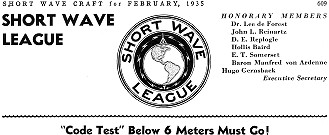|
February 1935 Short Wave Craft
 [Table
of Contents] [Table
of Contents]
Wax nostalgic about and learn from the history of early electronics. See articles
from Short Wave Craft,
published 1930 - 1936. All copyrights hereby acknowledged.
|
This article from an issue of Short
Wave Craft shows that the necessity for Morse code in order for amateur radio operators to ply
their hobby was in question as early as 1935. Elimination of the requirement to demonstrate
proficiency in Morse code when earning an Amateur Radio license did not formally begin until
1991 - nearly 60 years later - when the 5-words-per-minute code test for the
entry-level Technician level license was removed. It was done so to prevent scaring off potential
newcomers who might otherwise seek an operator's license. Licensee numbers had been on the decline
for years prior and with cellphones for ubiquitous communications on the horizon, the need for code
skills were no longer deemed essential as part of the ARRL's charter to provide assistance with
communications during emergency and wartime scenarios. The FCC dropped the Morse code requirement
for all license levels in
2007, which does not sit well with many old-timers. I know a Ham who has been an
ARRL "Life Member" since the cost was $120 (today it will set you back
$1,225), and he refers to
"codeless" amateur licensees as "10-4-Good-Buddy Hams" (i.e., glorified
CBers). I think it's funny even though I fall into that category.
Short Wave League: Code Test Below 6 Meter Must Go!

Editor, Short Wave Craft (aka Hugo Gernsback):
I wish you would kindly print the following regarding the "Code or No Code" controversy:
Two people within hearing distance of each other cannot make themselves understood without the aid
of a telegraph key.
Q. Why not? Don't they both speak the same language?
A. Yes, but even if they didn't they would still need an interpreter.
Q. Then why do they need a key?
A. It's an old "Spanish" custom.
Q. But why don't they hold their conversation with their voices '?
A. It's too simple and easy. The more difficult way is the best. Besides, they both can use a key.
Q. Strange! What manner of people are these?
A. They are what are known as "Hams". A very jealous and clannish tribe, most of them, inclined to
be backward, and against progress; and very much addicted to "code."
Q. What is "code?"?
A. An old and obsolete method of ex-pressing one's self for great distances over the air before the
discovery of the modulated wave.
Q. What is a modulated wave ?
A. A means of transmitting speech over the air for great distances.
Q. Which method will cover the greatest distance?
A. Under the same given conditions the code - or C.W. waves - will carry further with more consistent
success.
Q. Can phone transmission be perfected so that it will equal or better the performance of the C.VV.
transmitter?
A. Nothing is impossible. When this comes to pass you will see the telegraph, key buried without
any false sentimentality
Posted January 6, 2017
|










